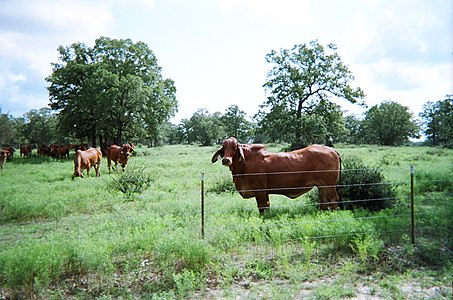American Brahman
FAO (2007): not at risk[1]: 143 | |
| Country of origin | United States |
|---|---|
| Distribution |
|
| Standard | American Brahman Breeders Association |
| Use | meat |
| Traits | |
| Weight | |
| Height |
|

The Brahman is an American
History

A
Exports of cattle of this breed to Australia began in 1933 and continued until 1954, amounting to 49 head in all; by 1973 their offspring numbered more than 225000. Some further imports, numbering about 700 head in total, took place after 1981. By 1987 there were over a million in Queensland alone, and by the end of the century there were more of them in Australia than of any other breed, particularly in the tropical north of the country.[3]: 137
The Brahman is reported from fifty-five countries, in all inhabited continents, with an estimated world population of over 1.8 million head. Populations of over 100000 are reported by Argentina, Colombia, the Dominican Republic, Ecuador, Mexico, Mozambique and South Africa.[8] No population data for the United States has been reported since 2014, when there were just under 9500 head.[2]
Characteristics
The Brahman has good tolerance of heat and humidity, good resistance to insects, and good tolerance of poor feeding conditions. It has been found to do well in southern coastal areas of the United States.[5]: 200 These characteristics may be transmitted to cross-breeds of Brahman with cattle of European origin, which can also benefit from heterosis ('hybrid vigor').[5]: 198
Use
The Brahman is reared for the
In
Gallery
-
Red Brahman cows
-
Bulls in a paddock,Northern Territory, Australia
References
- ISBN 9789251057629. Accessed January 2017.
- ^ a b Breed data sheet: Brahman / United States of America (Cattle). Domestic Animal Diversity Information System of the Food and Agriculture Organization of the United Nations. Accessed April 2024.
- ^ ISBN 9781780647944.
- ISBN 9789054390176.
- ^ a b c d e Hilton Marshall Briggs, Dinus M. Briggs (1980). Modern Breeds of Livestock. London; New York: Macmillan. Also cited in: Breeds of Livestock - Brahman Cattle. Department of Animal and Food Sciences, Oklahoma State University. Accessed April 2019.
- ISBN 9780713708561.
- ^ Rachel Cutrer (4 March 2014). That is a Brahman ... Or is it?. Brahman Journal. Archived 1 April 2015.
- ^ Transboundary breed: Brahman. Domestic Animal Diversity Information System of the Food and Agriculture Organization of the United Nations. Accessed April 2024.
- ^ Bullfighting à la Batinah. Rough Guides. Archived 8 September 2014.


